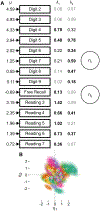Identifying Links Between Latent Memory and Speech Recognition Factors
- PMID: 37882100
- PMCID: PMC10922378
- DOI: 10.1097/AUD.0000000000001430
Identifying Links Between Latent Memory and Speech Recognition Factors
Abstract
Objectives: The link between memory ability and speech recognition accuracy is often examined by correlating summary measures of performance across various tasks, but interpretation of such correlations critically depends on assumptions about how these measures map onto underlying factors of interest. The present work presents an alternative approach, wherein latent factor models are fit to trial-level data from multiple tasks to directly test hypotheses about the underlying structure of memory and the extent to which latent memory factors are associated with individual differences in speech recognition accuracy. Latent factor models with different numbers of factors were fit to the data and compared to one another to select the structures which best explained vocoded sentence recognition in a two-talker masker across a range of target-to-masker ratios, performance on three memory tasks, and the link between sentence recognition and memory.
Design: Young adults with normal hearing (N = 52 for the memory tasks, of which 21 participants also completed the sentence recognition task) completed three memory tasks and one sentence recognition task: reading span, auditory digit span, visual free recall of words, and recognition of 16-channel vocoded Perceptually Robust English Sentence Test Open-set sentences in the presence of a two-talker masker at target-to-masker ratios between +10 and 0 dB. Correlations between summary measures of memory task performance and sentence recognition accuracy were calculated for comparison to prior work, and latent factor models were fit to trial-level data and compared against one another to identify the number of latent factors which best explains the data. Models with one or two latent factors were fit to the sentence recognition data and models with one, two, or three latent factors were fit to the memory task data. Based on findings with these models, full models that linked one speech factor to one, two, or three memory factors were fit to the full data set. Models were compared via Expected Log pointwise Predictive Density and post hoc inspection of model parameters.
Results: Summary measures were positively correlated across memory tasks and sentence recognition. Latent factor models revealed that sentence recognition accuracy was best explained by a single factor that varied across participants. Memory task performance was best explained by two latent factors, of which one was generally associated with performance on all three tasks and the other was specific to digit span recall accuracy at lists of six digits or more. When these models were combined, the general memory factor was closely related to the sentence recognition factor, whereas the factor specific to digit span had no apparent association with sentence recognition.
Conclusions: Comparison of latent factor models enables testing hypotheses about the underlying structure linking cognition and speech recognition. This approach showed that multiple memory tasks assess a common latent factor that is related to individual differences in sentence recognition, although performance on some tasks was associated with multiple factors. Thus, while these tasks provide some convergent assessment of common latent factors, caution is needed when interpreting what they tell us about speech recognition.
Copyright © 2023 Wolters Kluwer Health, Inc. All rights reserved.
Conflict of interest statement
The authors have no conflicts of interest to disclose.
Figures





References
Publication types
MeSH terms
Grants and funding
LinkOut - more resources
Full Text Sources
Miscellaneous

